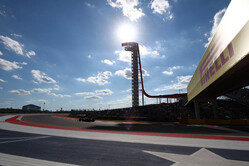 Red Bull's sprint race winner Max Verstappen will start on pole tomorrow after topping qualifying for the United States Grand Prix.
Red Bull's sprint race winner Max Verstappen will start on pole tomorrow after topping qualifying for the United States Grand Prix.
Qualifying got underway at 16:00 local time in track temperatures that reached 48 degrees centigrade, with gusting winds making the task of controlling the cars through COTA's high-speed direction changes even harder.
Verstappen was fastest in all three sessions, on each occasion using the soft compound. However, he only needed one run in Q3 to claim pole in a time of 1m32.510s, as he missed the cut-off to start his second flying lap at the end of the session. McLaren's Lando Norris by contrast improved during his second run to line up in P2, while Ferrari driver Charles Leclerc will start third.
Qualifying was interrupted by a red flag right at the beginning of Q1, following an off for Racing Bulls driver Isack Hadjar, before any drivers had the chance to put down a time. The biggest challenge however was the very high track temperatures, with tomorrow's race - which gets underway at 14:00 local time - expected to be slightly cooler. Track limits were another factor, with a number of laps deleted, while many drivers waited to start their quick laps for as long as possible to take advantage of an evolving track.
Interestingly, the polesitter hasn't won at COTA since 2021 - but on that occasion it was Verstappen, who today claims his seventh pole of the 2025 season.
The Pirelli Pole Position Award was given to Verstappen by Zachary Levi. The American actor plays superhero Shazam in the two films of the same name inspired by the legendary cartoons from DC Comics. Levi also starred in the two blockbusters of the Thor saga, as well as the hit TV series 'Less than Perfect' and 'Chuck'.
Red Bull's Max Verstappen underlined his mastery of the sprint race format by claiming his 13th win since the concept was introduced in 2021: more than half the total of sprints ever held. The result closed him to within 55 points of the championship lead.
All the drivers selected Pirelli's medium compound for the 19-lap race, which was characterised by two safety car periods. With drivers pushing flat-out when it was clear to race, the challenge for the tyres was increased by the track temperature and plenty of debris on the surface caused by a first-lap collision that eliminated both McLarens.
A second safety car with three laps to go lasted until the end of the race, with the Mercedes of George Russell - the only driver in the top three to start on a used set of tyres - finishing runner-up, ahead of the Williams of Carlos Sainz. This was the second podium of the year for the Spaniard, with the top three echoing that of the Azerbaijan Grand Prix.
Mario Isola: "As expected everyone opted for the mediums to start the sprint race, with the only variable being whether they were new or used. Degradation was high but predictable, especially following the neutralisation, which then allowed the drivers to push hard without worrying about tyre management.
When it came to qualifying, the times were set using new soft tyres. The high track temperatures made it harder for the tyres to recover their performance after the first flying lap. As a result, the drivers really only had one chance to beat their rivals, with lap times that were a bit slower than expected precisely because of the high track temperatures.
The hard tyre now becomes a valid strategic option for tomorrow's race, given that the performance gap to the medium is less than expected. Looking at all the available compounds, a number of different strategies are possible with no significant disadvantages: all of which are close in terms of overall race time.
Stretching the first medium stint to a pit stop window between laps 20 and 26 allows a one-stopper, if you then go onto the C1. But a two-stopper is equally effective using soft and medium: starting on the soft and then swapping to the C3 on between laps 12 and 18. The teams can then decide whether or not to run the medium again for the final stint, or stretch the middle stint and use the extra speed of the soft in the final laps.
A one-stopper using just medium and soft would require extremely accurate tyre management and might risk compromising performance, to the extent that we don't believe it would be a realistic option.
As we saw clearly today, the drivers will have to pay close attention to two external factors that made driving conditions tricky: gusting winds and irregular asphalt. The first issue adds to the risk of locking up under braking and so can potentially reduce the operating window of the tyres. The uneven asphalt can instead cause micro-slides, which raises tyre temperature and so adds to the challenge of thermal management."
Check out our Saturday gallery from COTA here.






















sign in